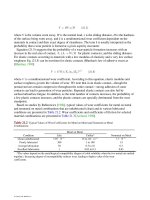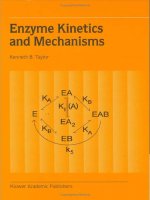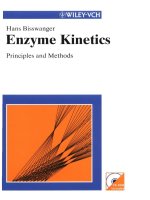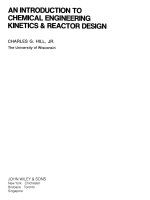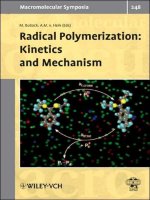enzyme kinetics and mechanisms
Bạn đang xem bản rút gọn của tài liệu. Xem và tải ngay bản đầy đủ của tài liệu tại đây (6.88 MB, 237 trang )
ENZYME KINETICS AND MECHANISMS
Enzyme Kinetics
and Mechanisms
by
KENNETH B. TAYLOR
University of Alabama at Birmingham, U.S.A.
KLUWER ACADEMIC PUBLISHERS
NEW YORK, BOSTON, DORDRECHT, LONDON, MOSCOW
eBook ISBN: 0-306-48025-5
Print ISBN: 1-4020-0728-0
©2004 Kluwer Academic Publishers
New York, Boston, Dordrecht, London, Moscow
Print ©2002 Kluwer Academic Publishers
All rights reserved
No part of this eBook may be reproduced or transmitted in any form or by any means, electronic,
mechanical, recording, or otherwise, without written consent from the Publisher
Created in the United States of America
Visit Kluwer Online at:
and Kluwer's eBookstore at:
Dordrecht
To the colleagues who showed the way
and
to the students who taught me.
vii
TABLE OF CONTENTS
Dedication
Table of Contents
Preface
Introduction
Introduction to Steady-State Kinetics
The Generation of Experimental Data
Methods for Model Evaluation
Derivation of Mathematical Models
Effects of Substrate Concentration
Effects of Analog Inhibitors
Effects of Product Inhibitors
Effects of Substrate Inhibition
Slow and Tight Inhibition
The Thermodynamics of Initial Velocity
Effects of pH
Effects of Isotopic Substitution
Effects of Other Reaction Conditions
Index
1.
2.
3.
4.
5.
6.
7.
8.
9.
10.
11.
12.
13.
v
vii
ix
xi
1
7
14
27
44
66
89
106
122
147
164
184
206
223
ix
PREFACE
It is said that necessity is the mother of invention. Although this seems to be true, I suspect
that indolence also has something to do with it and perhaps some paternity testing would
be in order. Such was the case with the present book. The necessity was provided by the
circumstance that I was to teach a course about a steady-state kinetics approach to the
elucidation of enzyme mechanisms, but in the apparent absence of a suitable textbook I was
forced to develop my own teaching materials. The putative father of this book was my
disinclination to burden myself and the students any more than necessary with long,
convoluted derivations and explanations as well as to attempt an exhaustive literature
review. Therefore, the approach taken was the shortest and simplest I could find. The
success or failure of this approach is to be determined by you the reader.
In addition the ancestry of this book includes the efforts and forbearance of several
other individuals. Dr. Tim Fritz, Staff Scientist at the National Institutes of Health,
NIDDK, read the manuscript and made many comments that improved the clarity of the
book very significantly. His efforts are greatly appreciated.
Dr. W. W. (Mo) Cleland was not only instrumental in the development of much
of the science described here but provided me, a number of years ago, with an introduction
to it and an opportunity to learn some of it. I am grateful.
Dr. Herb Cheung and Dr. Jeff Engler, both of the Department of Biochemistry and
Molecular Genetics at the University of Alabama at Birmingham, provided needed
encouragement.
Finally I am grateful to my wife, Carol, who exercised generous forbearance that
allowed me to develop the material and write the manuscript during time that otherwise
could have been devoted to joint activities and concerns.
Verona, Maine
Summer 2001
xi
INTRODUCTION
Although the rate of appearance in the scientific literature of rigorous
investigations of enzyme mechanisms by steady-state kinetics seems to have declined
somewhat in recent years, it remains rather steady. Nevertheless the usefulness of such
studies remains rather high, because the functions of enzymes are fundamentally kinetic
in nature. More specifically the possibilities for rate and mechanistic perturbation due to
the substitution of specific amino-acid residues by genetic engineering have enhanced the
need for rigorous kinetic studies to define the effects of these changes. With the present
availability of site-directed mutants, a plethora of structural information and the possibility
for comparison of very closely related enzymes, investigations of steady-state kinetics
assume even greater importance.
Two factors further enhance the relevance of investigations of enzyme
mechanisms by steady-state kinetics. First the experimental conditions are generally close
to physiological conditions. Specifically the enzyme concentration is much less than the
substrate concentration both physiologically and for steady-state experiments, as well as
necessary for the interpretation of the experimental results. In addition the temperature,
the pH, the pressure and the solvent are usually closer to the physiological than is the case
with other experimental techniques. Second, the experiments generally require rather
simple equipment. As explained in a later chapter a good spectrophotometer and a
computer are generally the most sophisticated equipment necessary for most investigations.
However, additional analytical and control equipment may be required for some enzymes
and for some types of experiments.
The overall objective of the study of enzyme reaction mechanisms is the
description of the intermediates and transition states in the reaction. Since there are some
intermediates and transition states that are not accessible by these techniques,
investigations of steady-state enzyme kinetics have a focus on a subset of these objectives
that will be described later.
There are three major objectives of this book. The first is to describe the useful
experimental manipulations for the production of steady-state kinetic data as well as their
interpretation in order to give the reader an approximation of the magnitude of effort
required to complete a meaningful investigation. Second, this book purports to describe
the interpretation of data in sufficient detail to enable the reader to understand the principal
paths of logic associated with steady-state enzyme kinetics. Specifically the reader should
be able to understand the logic in the literature that connects hypothesis and data from
steady-state kinetic experiments, and the reader should be able to formulate and use steady-
state kinetics experiments and logic in the elucidation of the mechanism of enzymes.
Although it is expected that the reader may want to consult some of the more detailed
descriptions of individual approaches that are cited in the text, the present book will be
invaluable in the understanding of these descriptions.
The third objective of this book is to expound several approaches to the theory of
steady-state enzyme kinetics in a context somewhat different from previous discussions in
an attempt to make them relatively easily understood while maintaining a standard of
rigorous logic.
This book is not meant to be a scholarly or an exhaustive treatise on enzyme
kinetics and mechanisms. Whereas examples from the literature will be presented, a
review of the literature is not a purpose of the book. There are a number of excellent and
comprehensive treatises on enzyme kinetics and mechanisms to which reference will be
made. The present book is intended to aid in the understanding of these treatises.
Furthermore, this is not meant to be a reference book, although it may serve that function.
There are other compendia of steady-state mechanisms, e.g. [1].
This book is for anyone who expends the funds in its purchase. More specifically
it is most appropriate for someone who has had an entry-level introduction to enzymes and
steady-state kinetics and would like to understand the subject in more detail. The material
herein was developed for a graduate level course in enzyme mechanisms and kinetics
taught by the author over a period of fifteen years. An understanding of the book will
require about an American secondary-school level of knowledge of algebra and analytical
geometry. The really necessary concepts will be reviewed very briefly. Some
understanding of calculus is necessary to understand the curve-fitting algorithms and the
slow inhibitors, but these are not essential for the understanding of steady-state enzyme
kinetics. An understanding of the material in this book does require the motivation to
indulge in the algebraic thought processes to derive the necessary equations. Equations are
central to the approach in this book and are basic for a conceptual understanding of the
theory of steady-state enzyme kinetics.
The book is divided into five general sections. In the first section the first three
chapters deal respectively with some important basic concepts of steady-state kinetics,
methods for the generation of data, and methods for the use of that data in the testing of
mathematical models for the mechanism. In the following chapter several methods for the
derivation of mathematical models are described. One of these methods will be employed
throughout the remainder of the book. Therefore, it is important to have an understanding
of this chapter in order to understand the remainder of the book. The third section consists
of four chapters in three of which models are described respectively to deal with initial-
velocity data from experiments in which the concentration of substrate, of analog
inhibitors, and of product inhibitors are varied respectively. The latter section also includes
a chapter about models for substrate inhibition. In a departure from strictly initial velocity
models the fourth section consists of a chapter containing a description of models for tight-
binding inhibitors, slow-binding inhibitors and slow-, tight-binding inhibitors, because of
their importance and because the models depend on many of the same concepts as initial-
velocity models. The final section contains Chapter 10 with a discussion of the
xii
xiii
thermodynamics of initial velocity and general models for the description of the effects of
changes in environmental conditions, and other reaction conditions on the initial velocity.
An understanding of this chapter is important for the understanding of the final three
chapters, which present specific models for the description of the effects of pH, isotopic
substitution and other factors, such as temperature and pressure, on the initial velocity.
References
1.
Segal, I.H. Enzyme Kinetics, Wiley Interscience, New York, 957pp (1975).
CHAPTER 1
STEADY-STATE KINETICS
1.1. Introduction
This book contains a number of concepts and agendas implicit in steady-state enzyme
kinetics that will hopefully be made explicit in this chapter. Specifically this chapter will
contain a description of the steady state as well as the assumptions and approximations
associated with it. It will contain a general description of the things that can be learned
from and the limitations of investigations of steady-state enzyme kinetics. Finally a
generally useful sequence of experiments in an investigation of steady-state enzyme kinetics
will be described.
1.2. What is the Steady-State?
In a prototypical experiment an enzyme reaction is initiated by the combination of free
enzyme and substrate rather instantly compared to the other things that happen, whether
this is accomplished by the simple addition of enzyme to a reaction with a pipette or it is
done with a very fast stopped-flow instrument. The period immediately after the initiation
is characterized by the increase in concentration of the downstream intermediates of the
reaction and is called the pre-steady-state period. The pre-steady-state period is followed
by a second period during which these intermediates of the reaction are in relatively
constant concentration. During the latter period the approximations necessary for steady-
state kinetics are most accurately realized, and it is called the steady-state period. During
the steady-state period the rate of the appearance of product is most nearly constant. This
is called the initial velocity of the reaction.
These phenomena can be illustrated in a simulated reaction (Figure 1.1) in which
the free enzyme (E) forms an enzyme-substrate intermediate (EA) and the latter
subsequently forms an enzyme-product intermediate (EP), which dissociates to product (P)
and free enzyme. It can be seen that the product concentration endures a short lag period,
while the concentration of both intermediates increases with time. Then the product
concentration increases rather linearly with time, while the concentration of both
intermediates remains relatively constant. This second period is the steady-state period and
the rate of formation of product is the initial velocity. The previous lag period is frequently
1
2
CHAPTER 1
sufficiently short that it is
insignificant in the measurement
of initial velocity. In fact special
equipment is frequently required
to investigate this pre-steady-state
p e r i o d. F i n a l l y
the product concentration will
increase more slowly as the
reaction either approaches
equilibrium or the substrate
concentration becomes so low that
the rate of formation of the
enzyme-substrate complex (EA)
becomes rate limiting, or both. In
an irreversible reaction only the rate of formation of the enzyme-substrate complex limits
the reaction rate in this third period.
1.3. Assumptions and Approximations
There are five interrelated assumptions that must be at least approximated in order to
perform and interpret valid initial-velocity experiments (Table 1.1)
Although not strictly true the assumption of the constant concentration of all
enzyme forms in the reaction is most closely approximated during the steady state. The
interpretation of data and the mathematical models are predicated on this assumption, and
the other assumptions are related to it.
It is assumed that initial velocity can be measured or at least approximated closely,
and that this is a measure of the velocity during the steady state. Ideally, but not always,
this rate is constant within the limits of measurement precision for a finite period of time,
and this constancy is a criterion for initial velocity. For reasons that should be investigated
some enzymes under some conditions demonstrate a burst or a lag in the velocity at the
Table 1.1. Assumptions for initial-velocity experiments.
1.
2.
3.
4.
5.
The concentration of all enzyme forms are constant during the measurement.
The measured initial velocity is the steady-state velocity.
The concentration of substrate (and inhibitors) is constant.
The concentration of at least one product in negligible during measurement.
All other reaction conditions are constant during measurement.
STEADY-STATE KINETICS
3
beginning of the reaction, which may or may not reflect the pre-steady-state rate. It is not
unusual for an investigator to ignore the burst or lag and measure the constant rate that
follows.
The steady-state period is prolonged when the concentration of substrate is much
greater than the concentration of enzyme, perhaps at least 100-fold. In addition as
demonstrated later this is a requirement and simplifies the derivation of mathematical
models, since it circumvents the necessity for the acknowledgment of the disappearance of
substrate in derivation of steady-state models. Therefore, it is assumed that the
concentration of substrate remains the same as that put into the reaction mixture initially.
This requirement for a relatively small concentration of enzyme sometimes limits the kinds
of enzymes with which steady-state investigations can be conducted. For example
investigations with polymerases and nucleases are limited because an easily detectable
reaction rate frequently requires concentrations of enzyme comparable to that of the
polymer template or substrate respectively.
In addition to the constant substrate concentration it is assumed that the
concentration of the product; or at least of one of the products, if there are more than one;
of the reaction is zero during this period. This approximation also simplifies the derivation
of mathematical models considerably, since the step in which this product is released is
considered to be irreversible, and there is no overall reverse reaction with which to be
concerned. This approximation sometimes seems to be a contradiction in terms, since one
may be measuring the rate of formation of product before there is significant product.
However, the apparent contradiction is the same as that associated with any instantaneous
rate or slope and the approximation does not generally present practical problems.
The final assumption is that the change in other conditions during the period of
measurement of initial velocity is negligible. Specifically it is assumed that the pH,
temperature, and ionic strength are constant during the period of measurement. Although
the pH is generally controlled by the use of a buffer, some precautions will be discussed
later along with other methods. Temperature control is a technical matter and will also be
discussed along with other methods. Changes in ionic strength are generally not a
problem.
Operationally there are some tests that may lend confidence that initial velocity
is actually measured, but these will be discussed along with other methods.
1.4. What Can be Learned?
In general several kinds of mechanistic hypotheses can be tested with data from steady-state
kinetic investigations. Most commonly one can learn about the substrate binding steps, the
steady-state mechanism. It is possible to test hypotheses about ordered binding, random
binding, rapid-equilibrium binding and other similar hypotheses. In addition it is possible
to test hypotheses about the order of product release. When the initial velocity can be
measured in both directions, one can learn about the substrate binding steps in both
4
CHAPTER 1
directions. Furthermore in favorable cases minor pathways of substrate binding and
product release can be identified.
Steady-state data can be used to test certain kinds of hypotheses about the steps
between substrate binding and product release and more limited hypotheses about the steps
between product release and substrate binding. The meaningful data comes from
experiments in which the steady-state kinetic parameters are measured under various
environmental permutations (e.g. pH, temperature, ionic strength), enzyme permutations
(
e.g. site-directed mutants) and substrate permutations (e.g. analogs, isotopic substitution).
Hypotheses can be tested about the identification of the rate-determining processes and the
extent to which certain processes are rate-determining can be determined. For example it
can be determined whether the rate-determining processes involve the breaking, the
forming or changes in hybridization of specific bonds in the substrate. In addition essential
acidic or basic groups on the enzyme can be detected. Furthermore, hypotheses about their
identity as well as their role in the reaction can be tested.
1.5. The Limitations
In spite of the optimistic possibilities for steady-state data there are a number of limitations
to the kinds of enzymes that can be investigated and the hypotheses that can be tested.
Therefore, the elucidation of an enzyme mechanism requires the steady-state data and the
hypotheses confirmed or eliminated along with data and hypotheses from other techniques
such as x-ray crystallography, fast-reaction kinetics, and others.
Certain kinds of enzymes are difficult to study. Polymerase and depolymerase
enzymes are frequently difficult, because the polymer, either template or substrate, is
frequently necessary in concentration comparable to that of the enzyme in order to measure
a significant reaction rate. Therefore, the polymer cannot be treated as a substrate for
steady-state modeling purposes, and investigations with these enzymes are limited.
In addition it is possible to test hypotheses about the number and kinds of
intermediates and transition states between the binding of substrate and the release of
product only indirectly by the effects of certain reaction conditions on the steady-state
parameters. Furthermore the testing of hypotheses about specific chemical groups involved
in the catalytic reaction is limited to the possible identification of specific essential acidic
and basic groups on the enzyme under favorable circumstances.
Finally there are technical reasons why particular enzymes cannot be investigated
as thoroughly as desired by steady-state kinetics. The most common reason is the absence
of a satisfactory method by which to measure initial velocity. For reasons explained later
it is very advantageous to be able to measure the initial velocity continuously in real time.
However, the investigator’s ingenuity is sometimes challenged beyond its limits to find a
satisfactory method to accomplish such measurements and less satisfactory methods must
be employed.
Another common reason is the relative scarcity of the physiological substrate in
STEADY-STATE KINETICS
5
a pure or even a well characterized preparation. For example investigations of a number
of the hydrolases are limited by the fact that the physiological substrate is relatively scarce
and expensive. In many cases even if it were readily available, neither it nor the product
has a unique physical property by which to detect its disappearance or appearance
respectively in a continuous manner in real time.
1.6. A Sequence of Investigation
Although they are not always conducted in this sequence, there is a favored logical
sequence to steady-state investigations. Ideally an enzyme should be investigated in this
order. Some detailed planning of the investigation at the beginning can prevent the
laborious repetition of some experiments later. For example there is some advantage in the
selection of a pH, temperature and substrate with which the reaction can be investigated
with some convenience in both directions. However, the results and conclusions will be
more useful if these conditions are kept as close to physiological as possible.
It is useful to spend some time at the beginning to establish the reaction conditions
under which the remainder of the investigation will be carried out. The method for the
measurement of initial velocity should be rapid and convenient and result in precise,
repeatable data. It is best to design a method that is sufficiently robust that equipment is
not operating at its limits in order to avoid instrumental variability later. The conditions,
particularly the pH, should be easily controlled and such that the initial velocity is relatively
insensitive to small changes. It is also useful to streamline the manipulations required in
the assay procedure, because it will be repeated many times.
After preliminary experiments are completed to establish the best conditions for
the rest of the investigation, the investigation can be conducted in approximately the same
order as the chapters in this book. First it is useful to generate the data and test hypotheses
about the steady-state mechanism for binding of substrate and product. The latter generally
requires data from experiments in which the initial velocity is measured at various
concentrations of substrate, reversible analog inhibitors and product inhibitors. It is useful
to carry out the experiments in both directions of the reaction, if possible. This is also a
good time to test hypotheses about the release of product in those cases in which it is
possible. Next, it is common to perform the experiments and test the hypotheses to
establish minor binding pathways, if possible. The latter requires data from experiments
with substrate inhibition.
Next it may be useful to perform the experiments to test hypotheses about the
effects of pH on the initial velocity, and finally is is useful to investigate isotope effects as
well as some of the environmental effects in order to test hypotheses about the rate-
determining steps. Data from experiments to measure the effects of changes in reaction
conditions is more easily interpreted if hypotheses about the steady-state mechanism have
previously been verified. However, since it is possible to investigate isotope effects as well
as the effects of other substrate permutations without actually measuring the initial velocity
6
CHAPTER 1
per se, some of the initial-velocity investigations may be attenuated somewhat in order to
hasten the investigation of the former, particularly in those cases in which the initial-
velocity measurements are difficult, relatively unreliable or both.
The remainder of this book is to supply some of the methods and the logic by
which these investigations might be carried out.
CHAPTER 2
THE GENERATION OF EXPERIMENTAL DATA
In the present chapter will be presented some of the methods for the generation
of initial-velocity data. It is intended to give the reader a conceptual picture of the nature
of the investigation rather than to provide a comprehensive or complete description of every
method. In addition attempts are made to describe procedures that have been particularly
useful to improve the precision of the data and to minimize the manual labor involved.
Finally methods are described for the calculation of initial velocity from the data output of
the instruments used.
Most frequently the investigator will measure the initial velocity at various
concentrations of substrate and frequently at different values of at least one additional
reaction condition, which may be the concentration of an additional necessary substrate,
the concentration of a reversible inhibitor, pH, or the isotopic composition of some atom
of the substrate.
2.1. Experimental Objective
The objective of the experiments is to measure the concentration of product or of substrate
as a function of time elapsed, subsequent to the initiation of the reaction, and to determine
the slope of the initial part of the curve relating product concentration and time (e.g. Figure
1.1) or the corresponding initial part of a substrate-concentration curve. It is usually more
precise to measure changes in the product concentration than in the substrate
concentration, since the former will be a small change in a small concentration rather than
a small change in a large concentration. However, frequently other considerations take
precedence. Of course there are many methods for the determine the concentration of
product or substrate, but these will be a subject of the present chapter only in a
parenthetical way.
2.2. Experimental Methods
There are three general methods by which the initial-velocity data is generated, continuous,
discontinuous and coupled methods.
7
8
CHAPTER 2
2.2.1. CONTINUOUS METHODS
If either the substrate or the product of the reaction has some unique physical property that
can be measured in real time under the conditions of the reaction, that property may be
monitored continuously as a measure of the reaction progress. Most commonly advantage
is taken of the selective absorption of light by either a product or a substrate. Alternatively,
however, advantage may be taken of a selective change in another physical property. For
example the product of alcohol dehdrogenase (Figure 2.1), NADH, absorbs light at 340
mµ.
The success of this method is evident in the many steady-state kinetic investigations of
dehydrogenases. The continuous generation of data with analog recording or the
generation of numerous data points with digital recording permits a very precise
measurement of initial velocity.
2.2.2. DISCONTINUOUS METHODS
When neither the substrate nor the product can be selectively measured under the
conditions of the reaction, the reaction must be stopped and the measurement carried out
under different conditions. Measurement usually requires the chemical separation of
substrate and product with quantitation of one of them. A common example is the use of
a radioactive substrate with subsequent separation of substrate and product and the
determination of the radioactivity associated with the latter. This generation of a single
time point with each analytical sample constitutes a discontinuous measurement method.
Although frequently analysis at a single time point will provide an adequate
measure of initial velocity, initially a time course consisting of a number of samples should
be analyzed in order to establish that initial velocity is being measured. When the reaction
conditions are changed substantially this time course should be repeated. It can be seen
that the manual labor involved in a significant kinetic investigation by these methods can
become substantial. For this reason and because of the additional approximations involved,
discontinuous methods are less preferable that the continuous ones. If a single analysis by
a discontinuous method requires a significant amount of time, it is probably useful to spend
time working out some sort of continuous method before the initiation of a steady-state
kinetic investigation.
2.2.3. COUPLED METHODS
In some cases a discontinuous assay method can be avoided, when a product of the reaction
of interest can be the substrate of a second enzyme whose reaction can be measured
continuously. This constitutes a coupled assay method.
The second enzyme, the coupling enzyme, as well as any necessary additional
substrates should ideally be readily available in quantity, since it is necessary to employ
them in high concentration in order to insure that the coupling reaction keeps up with the
initial velocity of the reaction under investigation. Experiments should be done with
THE GENERATION OF EXPERIMENTAL DATA
9
various amounts of the components of the second enzyme reaction in order to demonstrate
that initial velocity is being measured, and these experiments should be repeated whenever
the reaction conditions are changed significantly. Although there is a mathematical model
with which the adequacy of these components can be calculated [1], it is done more easily
by measurement of the initial velocity with twice as much of the components for the
coupling reaction and determination whether the apparent initial velocity has increased
significantly. If not, there were probably enough of the components of the second reaction
at the lower concentration. If it does increase, additional determinations must be done to
insure that enough is present.
Since the coupled assay methods are continuous methods, considerable ingenuity
has been expended in their development and it is common to utilize more than one
coupling enzyme. For example the use of pyruvate kinase (PK) and lactate dehydrogenase
(LDH) in the presence of phosphoenolpyruvate (PEP) and NADH is a common coupling
system for many phosphotransferase enzymes (t’ase) that produce ADP as one of their
products (Figure 2.2). With this method the disappearance of NADH is monitored
spectropotometrically at 340 mµ. The method has the additional advantage that the ADP
is recycled and the phosphotransferase
reaction is rendered essentially
irreversible.
2.3. Reaction Conditions
Of course those conditions that affect the rate of the reaction (e.g. temperature, pH and
ionic strength) must be as constant as possible both during a single measurement run and
from one run to another. It is common to monitor the reaction for a period of time prior
to initiation in order to confirm that the conditions are either constant or not affecting the
measurements being made.
2.3.1. TEMPERATURE
The temperature is generally controlled
(
e.g. ±0.1 °C.) by the use of a thermostated bath
or chamber in which the reaction takes place. Although the reaction temperature can be
the ambient temperature, the use of a thermostated bath or chamber is nevertheless
recommended, since the temperature in a room may change significantly from one day or
hour to the next. In addition a reaction temperature ten to fifteen degrees above ambient
can be controlled precisely and requires only heating for good control. Therefore, 37 °C
is a good reaction temperature in the interest of both good control and the physiology of
many of the enzymes of interest.
Also in the interest of good temperature control the reaction mixtures are
equilibrated to the reaction temperature before initiation of the reaction. It is usually best
to use a water bath for this purpose, since the heat conductivity is more rapid in it than in
10
CHAPTER 2
air. Frequently the reaction is initiated by the addition of a solution of enzyme that has
been maintained at 0 °C to 4 °C in the interest of stability. In order to maximize the
temperature control in these circumstances the enzyme, or any other initiating agent,
should be transferred in a sufficiently small volume that the temperature of the reaction
mixture is not affected significantly. Alternatively the initiating component can be pre-
equilibrated to the reaction temperature.
Temperature control at temperatures farther than twenty degrees from ambient is
complicated by the fact that it is difficult to make transfers of significant amounts of
solution to the reaction container with the maintenance of strict temperature control.
2.3.2. CONTROL OF pH
The pH of the reaction mixture is generally the optimum pH of the enzyme, the
physiological pH of the enzyme, or both, if they coincide. However, it may be quite
different from either of these for special purposes. Nevertheless the initial-velocity
assumptions and approximations should be verified whenever there is a significant change
in the pH of the reaction. The pH control during the reaction is generally maintained by
the use of a buffer. Nevertheless the investigator must be sensitive to the need to have a
sufficient concentration of buffer at a pH at which it has adequate buffering capacity. In
addition the measurement of the pH of at least one reaction mixture before and after the
reaction to confirm that the pH is accurate and that there is no significant change during
the measured reaction will provide a degree of confidence in the effectiveness of the buffer.
2.3.3. IONIC STRENGTH
The ionic strength of most biological reactions changes rather little during the reaction,
although the investigator should remain sensitive to the possibility. However, the addition
of ionic substances to subsequent reaction mixtures, particularly inhibitors, may change the
ionic strength significantly. When such a possible change is an issue, it may be useful to
determine the effect of a change in ionic strength more selectively by the addition of salt
in comparable concentration to the reaction mixture.
THE GENERATION OF EXPERIMENTAL DATA
11
2.3.4. SUBSTRATE CONCENTRATION
In the experimental protocol generally it is good to have at least five different
concentrations of substrate in each series of measurements. Unless others factors take
precedence, e.g. cost or solubility, a good rule of thumb is to have the range of
concentrations of substrate extend from one-fifth of the K
M
to five times the K
M
. In order
to promote uniformity of all of the reaction mixtures in an experimental series combine as
many of the nonvariable components of the reaction mixture as possible in a stock solution.
After the stock solution has been distributed into a series of separate reaction mixtures, add
the variable component, usually substrate.
In addition it is generally necessary to determine the exact concentration of
substrate in the stock solution of substrate in spite of the fact that it was carefully weighed
and made up to volume. It is frequently possible to conduct this determination
enzymatically in the presence of larger amounts of the same enzyme and sometimes under
somewhat different conditions (e.g. pH) in order to encourage the reaction to go to
completion and do so in a convenient period of time.
Although reaction mixtures of very small volume (e.g. 0.1-0.2 ml) are to be
avoided, if such volumes are necessary, special care must be taken to insure or at least
measure the precision of the volumetric transfers. Generally a microliter syringe is
preferable to a pipettor with changeable tips. The latter is more acceptable, if it is very
carefully calibrated, maintained and used. In addition to volumetric transfers special care
should be taken to insure complete mixing of such small volumes.
2.3.5. INITIATION OF THE REACTION
Frequently the reaction is initiated by the addition of a rather small volume of enzyme or
possibly substrate. The amount added must be as precise as possible. It is useful to
calibrate the instrument used for the addition in order to estimate its precision. The
addition of amounts less than about ten microliters and the calibration of the corresponding
instrument are both difficult to accomplish with acceptable precision. In addition, whether
it is the initiation agent or not, care must be taken to insure that the same amount of
enzyme is used from one experimental session to another, particularly when they are
separated by a significant period of time. It is frequently necessary to assay the enzyme
activity carefully before each experimental session to insure its uniformity.
The addition of enzyme, or substrate, and its even distribution in the reaction
mixture to initiate the reaction should be done rather quickly in order to insure the
collection of data constituting the initial velocity. For example in spectrophotometric
measurement methods it is possible to fabricate or purchase a stirring device consisting of
a small rod with a larger spoon or block on one end that transfers a small amount of liquid
and fits inside the cuvette. A few vertical motions with this device will mix the solution
in the cuvette.
12
CHAPTER 2
2.4. Calculation of Initial Velocity
There are a number of ways in which to calculate initial velocity from data, depending on
the method and the form of the data. In continuous measurement methods the initial
velocity can be determined from graphic data from a chart recorder by the construction of
the tangent with a straight edge and calculation of the slope of the tangent. Tabular data
in a computer file in a spreadsheet can be fit with a polynomial equation, usually second
or third order (methods in Chapter 3). The coefficient of the first-order term is the initial
velocity, since it is the value of the first derivative at the origin.
Data from discontinuous measurements frequently consists of a single point at a
time predetermined to be within a satisfactory approximation of the initial velocity period.
As stated above it is advisable to confirm this approximation frequently.
However, every method is associated with some dead time at the beginning of the
reaction during which acceptable data cannot be gathered. The dead time, which is most
apparent in continuous measurement methods, can be dealt with in several ways. If it is
quite short, it is usually ignored and the subsequent rate is measured as a sufficiently close
approximation of the initial velocity. If the dead time seems significant or if there is reason
to doubt the validity of the subsequent rate, the data can be extrapolated to zero time by a
fit to the data of a polynomial equation as described above or of the integrated Michaelis-
Menten equation. In addition the extrapolation to zero time is sometimes employed to
determine the initial velocity in the presence of an unexplained lag or burst of initial
activity.
When possible the initial-velocity data should be verified by testing it for linearity.
The pre-steady-state portion of the initial concentration changes is usually insignificant
with the usual methods for measurement. However, data should be inspected and tested for
confirmation of this fact. This can be accomplished by testing graphical data with a simple
straightedge or more elegantly with tabular data in a spreadsheet by linear regression. If
the initial-velocity period is so short that it must be determined by differentiation of the
progress curve, either by graphical or analytical means; it might be verified by
demonstration that the value is proportional to the concentration of enzyme.
2.5. Data Handling
Detailed data handling including the determination of the goodness of fit to
mathematical models, including the Michaelis Menten model, as well as the determination
of the parameter values by computer program is discussed in the following chapter.
However, it is good to plot the data initially, even while subsequent data collection is under
way, by one of the linear graphical methods such as double reciprocal, Lineweaver-Burke,
plots in order to provide assurance that there are no large problems with the data, while
there remains an opportunity to correct them.
THE GENERATION OF EXPERIMENTAL DATA
13
2.6. References
1.
Easterby, J.S. “Coupled Enzyme Assays: A General Expression for the Transient,”
Biochim. Biophys. Acta, 293, 552-8 (1973).
CHAPTER 3
METHODS FOR MODEL EVALUATION
3.1. Introduction
In investigations of steady-state enzyme kinetics generally two kinds of related questions
are asked. First, which mathematical model best describes the data? Second, how do the
kinetic parameters change with specific changes in reaction conditions, and is the change
significant? In the approach to the first question the data generated by the methods
outlined in the previous chapter will be tested for its fit to various mathematical models,
or equations. The values of the kinetic parameters result from the fit of the data to the
appropriate mathematical model. Thus the second question is approached when these
values are compared under different conditions.
The development of the models and their testing with data is known as
mathematical modeling. The present chapter describes the use of mathematical modeling
in testing models for data from investigations of steady-state enzyme kinetics. The purpose
here is for the reader to achieve an understanding of the process as well as the assumptions
involved and to be comfortable with the software available. Future chapters will deal with
the development of models. The reader is referred to more specialized descriptions for
additional details [1],[2].
Most often the various models will be fit to data by computer program. The
remainder of this chapter is meant to acquaint the reader with the algorithms that make up
the programs and with some of the specific programs themselves. However, in subsequent
chapters of this book the various models will be discussed in the context of graphical
presentation as double reciprocal plots, i.e. Lineweaver-Burke plots.
3.2. Mathematical Modeling
A mathematical model is an equation that contains one dependent variable, ordinarily the
initial velocity; one or more independent variables, e.g. substrate concentration; and one
or more parameters, e.g. the Michaelis constant. Unfortunately there is no way to test
whether a given model is the correct model. It is only possible to compare one model with
another. Therefore, it is only possible to identify the best model in a set. It is even more
convincing if the members of the set are closely related. Thus the selection of a model is
indirect, and the models in a set that do not fit very well are at least as important as the one
14
METHODS FOR MODEL EVALUATION
15
that fits best.
As will be seen in the remainder of the book the marriage of steady-state enzyme
kinetics and mathematical modeling has been a productive and happy one. One of the
reasons for the rather happy marriage between steady-state enzyme kinetics and
mathematical modeling is that the investigator is frequently faced with data and only a
limited set of reasonable mathematical models that are also related to each other.
Furthermore, in the author’s experience the selection of a best model from a small set of
chemically possible models to fit data from steady-state experiments has not generally been
a difficult choice.
Nevertheless, the investigator must be sensitive to the fact that in reality many
enzymes may have a chemical mechanism intermediate between two models. For example
an enzyme may result in data that fits a model for the sequential ordered binding of
substrates, whereas there may actually be slow steps for the opposite order of binding.
Thus, although the mechanism is partially random, the methods described may not be
sufficiently sensitive to detect it.
3.3. Data Fitting Methods
Before several mathematical models can be compared, the best fit of the experimental data
to each of the several models must be achieved. Operationally this process is to find the
optimum values for the parameters in the mathematical model that will minimize the
difference between the experimental values and the calculated values of the dependent
variable, i.e. initial velocity. For example if the equation is the single-substrate Michaelis-
Menten equation (equation 3.1, derived in the following chapter), the process is to find the
optimum values of and so that the values of initial velocity calculated at each
experimental substrate concentration are as close as possible to the values actually
measured.
Traditionally this has been done graphically by transformation of the model
equations to give an expression that is linear in the experimental variables, e.g. the double
reciprocal plot (Lineweaver-Burke plot) and related ones. The straight line is drawn either
graphically or mathematically by linear regression. The problem with these methods is that
the transformation of the data yields a new dependent variable whose values have different
standard deviations from each other, whereas regression or even graphic line construction
rests on the assumption that all points have the same standard deviations. For example if
the standard deviation of the original measurements of initial velocity is and the new
dependent variable, y, is 1/v; the standard deviation of y, will depend on the value of
